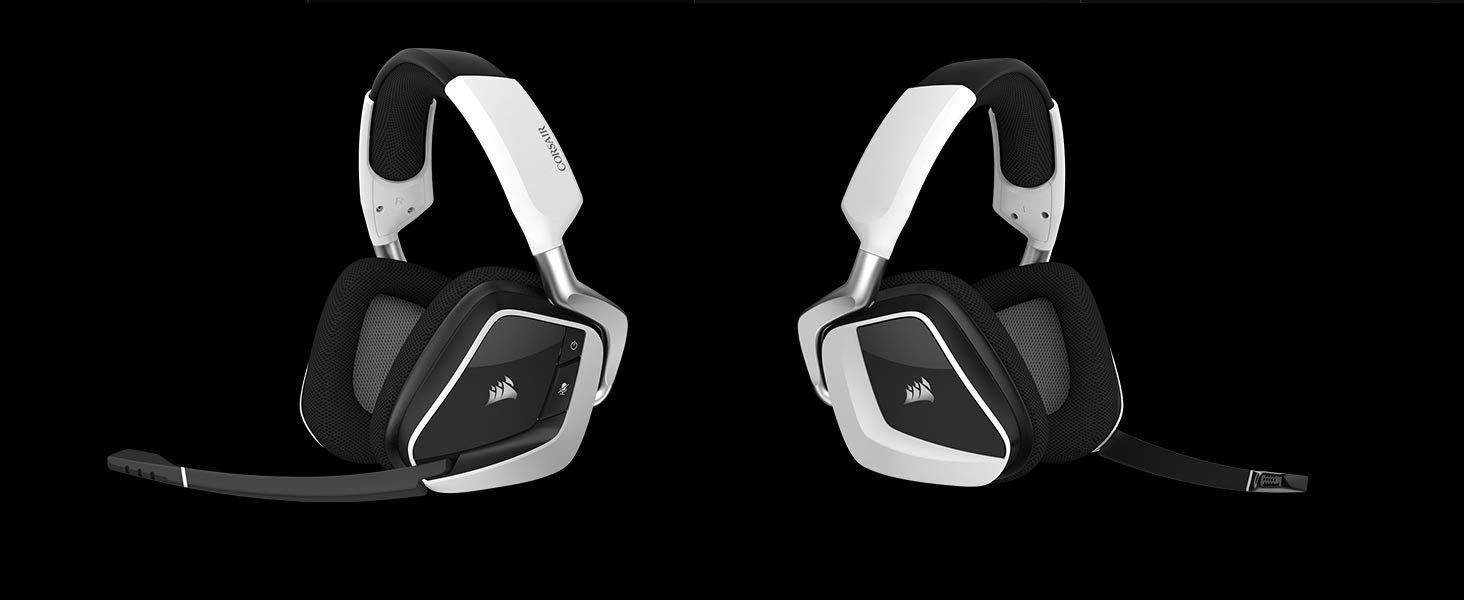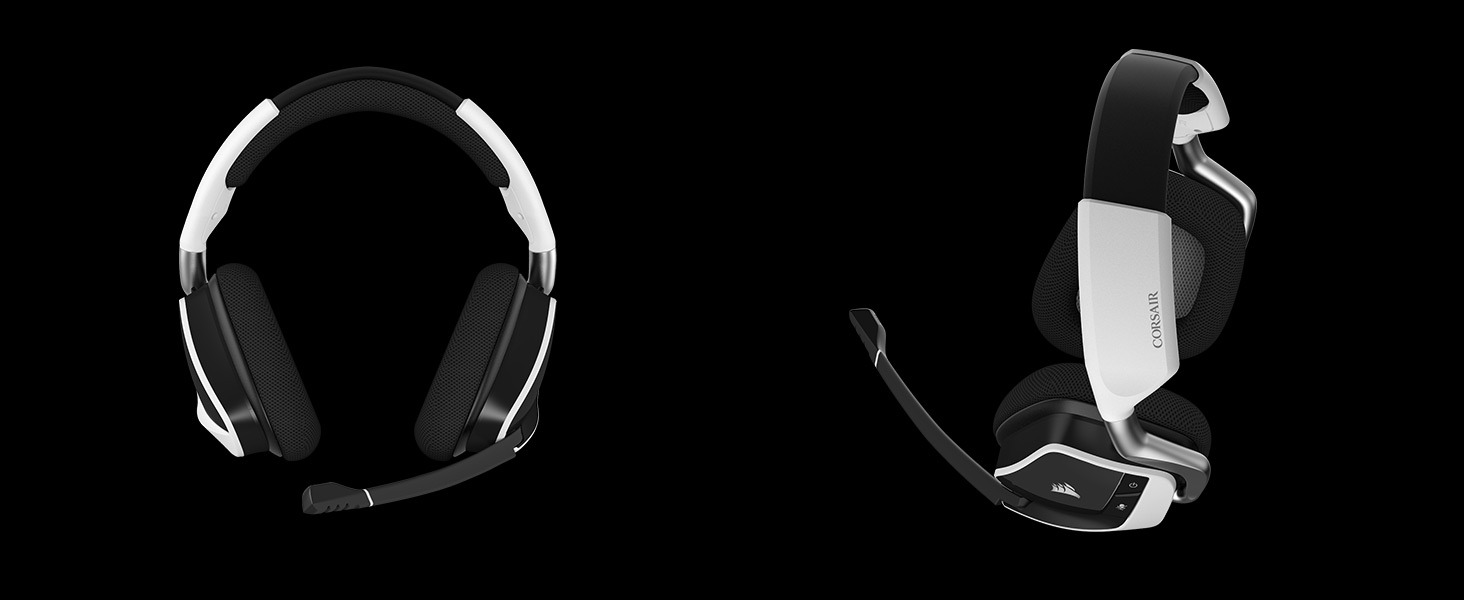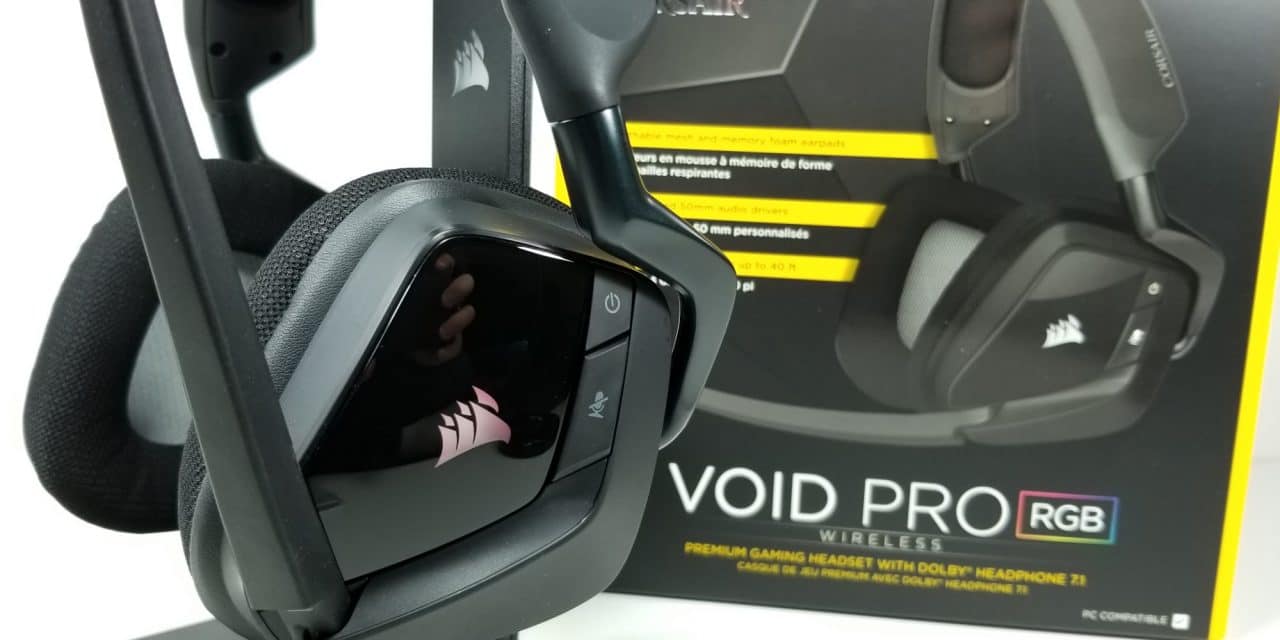Overview
Key features
| Wired/wireless connectivity: | None/included wireless transmitter* |
|---|---|
| Battery life: | 8–16 hours |
| Range: | Up to 40 feet (12m) |
| Headphone frequency response: | 20Hz–20kHz |
| Headphone sensitivity: | 107dB (+/-3dB) |
| Headphone impedance: | 32k Ohms @ 1kHz |
| Microphone type: | Unidirectional noise canceling |
| Microphone frequency response: | 100Hz–10kHz |
| Microphone sensitivity: | -38dB (+/-3dB) |
| Microphone impedance: | 2.0k Ohms |
| Price: | $69.99 and up* |
Pros & Cons
- Ridiculously good price
- (Mostly) great sound and recording quality
- Lightweight, yet fairly durable
- Oversized earphones feel loose on small and normal heads
- Short-ish battery life
- So-so bass
If you’re anything like me, any wireless headset that costs less than $100 warrants at least one raised eyebrow. I was initially skeptical when I first saw the Corsair Void Pro’s $70 price tag, but I’ve since come to believe that it’s an absolutely fantastic headset for the money. I might even go so far as to say that it outperforms some headsets that cost twice as much.
*Corsair does offer a less expensive wired version of this headset. In terms of specs, they’re otherwise identical, so consider this review applicable to both.
To put the numbers above in plain English for non-audiophiles, the Corsair Void Pro is, performance-wise, a $120 headset that costs much less. The bass kind of sucks, but the microphone is awesome, especially compared to the previous version of this headset. Otherwise, it’s slightly above-average all around.
Corsair Void Pro Gaming Performance
Setting up the Void Pro is as easy as it gets. The headset pairs automatically as soon as you plug in the transmitter and the audio is always crystal clear out to a range of about thirty feet. By installing the Corsair Utility Engine (iCUE) software, you can configure the equalizer and RGB lighting settings.
Speaking of RGB lighting—I have to confess, I don’t fully understand the massive appeal, especially on things like headsets, where you’re the only person who can’t see it.
The lights on the Void Pro can get pretty bright, and they’re great for cutting the battery life in half. The headset’s maximum 16-hour battery life (with lights off) is just okay compared to most of its competitors, so cutting that to 8–10 hours for the sake of lights you can’t even see strikes me as silly.

The Void Pro has what I would call B+ audio quality: it’s clear and loud (if you want it to be), but the tinny bass definitely leaves something to be desired. One of the biggest complaints about this headset’s predecessor (simply called the Void) was inferior recording quality, and Corsair has taken that to heart. With the Void Pro, you sound much better to others—no longer as though you’re talking through a can on a string while underwater.
However, be aware that Corsair’s claim of 7.1 surround support is rather misleading, if not outright false. Some wireless headsets can simulate 7.1 (true 7.1 requires multiple speakers), but the Void Pro can’t justifiably make even that claim; Windows 10 doesn’t recognize it as a surround-capable device and will only send stereo audio to it.
Finally, If you’re a Discord user (of course you are), you might like to know that the Void Pro is Discord certified, meaning that it’s tested to ensure that it performs well with popular games. That list changes over time, of course, and Discord periodically re-tests old products, meaning a headset can theoretically lose its certification, but as of this writing, the Void Pro is still on it.
All in all, while the Void Pro has a few noticeable shortcomings, it’s far more good than bad, especially in light of its great price.
Corsair Void Pro Design
Upon first laying eyes on the Corsair Void Pro, one can’t help but think that it looks a bit flimsy. It’s made mostly of plastic, and the headband looks concerningly thin near the earpieces. What isn’t immediately obvious, though, is that the weakest areas are actually made of metal and wrapped in plastic, so the headband is a fair bit sturdier than it appears at first glance.

When you put it on, you’ll notice that it feels fantastically comfortable—if you have a big head. The earpieces are oversized compared to most other wireless headsets, so if your ears (or your dome in general) are on the small side, the Void Pro will feel loose—maybe even liable to fly off if you move your head too fast. On the plus side, you’ll get marginally better airflow if they fit loosely, which helps ward off swampy ears.
Also, I don’t wear glasses anymore (thanks, Lasik!) but several bespectacled Amazon reviewers have noted that the Void Pro is very comfortable for them. Finally, it’s worth noting that the microphone automatically mutes when it’s flipped up (it can also be muted manually with a separate button). This is a great feature that more headsets should have, especially for those of us who don’t use push-to-talk (I’ll die first).
Tip: If you are using high-quality gaming glasses to protect your eyesight, this is a useful feature.
The headset even alerts you with an audible tone when the headset is muted or unmuted. Maybe that would help me break my habit of talking into a muted mic for five minutes before I realize it.
Corsair Void Pro Pricing & Alternatives
If we compare the Void Pro against two different classes of products—those that are priced similarly and those that perform similarly—we find that, given its price point, it’s an almost unbeatable headset. According to Amazon’s recommendation algorithms, two of the Void Pro’s biggest competitors are the Corsair HS50 and the Sades SA902, both of which are significantly cheaper but also can’t compete in either comfort or sound quality.

I currently use an Arctis SteelSeries 7, which could best be described as a bigger brother to the Void Pro. It costs more (currently $130 on Amazon), but it also has better core specs and a few extra nice-to-have bonus features. (My personal favorite is the secondary volume dial that can change chat and game volume relative to one another without having to futz around in your system audio settings.)
I’ve found that, although the SteelSeries 7 and some of its closest competitors are better than the Void Pro overall, you often have to spend at least 50% more to even approach the Void Pro’s level of quality.
If you’re looking for something priced similarly to the Void Pro with comparable specs, consider the Skullcandy PLYR2. It’s an older model, but it still keeps up with some of the best mid-tier wireless headsets in 2020. Exceptional range, clarity, and comfort for $65 make it worthy of serious consideration, though it’s a bit less durable than the Void Pro and lacks a few of its fancier features.

Finally, if you’re looking to stretch your headset budget as far as possible, the Logitech G430 is a surprisingly competent and ultra-affordable choice (it’s just $26.99 on Amazon). The audio quality is acceptable, but not great, and the headset isn’t wireless, but hey—you can’t even get a single meal at many restaurants for this price, so you really can’t complain too much. The G430 is better overall than most other budget gaming headsets.
Frequently Asked Questions
How do I connect my Void Pro wireless?
You can easily connect your Void Pro by plugging in the included transmitter and turning the headset on; it should pair automatically. If it doesn’t, try performing a factory reset (see next question). If you still can’t get it to connect, you may need to contact Corsair support, but we haven’t heard of any significant pairing problems with the Void Pro, so they seem to be pretty rare.
How do I reset my Corsair Void headset?
Should you experience connectivity problems, you can reset the headset by first turning it off, then using a paperclip to press and hold the small reset button on the connector (not the headset itself) for five seconds. Then turn the headset back on and it should reconnect.
Are wired headsets better than wireless?
That really depends on what you need your headset to do. Wired headsets are better if, to you, “better” means cheaper, more reliable, or (in some cases) marginally better audio quality. Transmitting audio wirelessly is a super complicated process, so eliminating that extra step between your game and your ears makes things simpler, and therefore more reliable.

Still, modern wireless headsets are generally pretty rock-solid, and if they don’t sound quite as good as their wired counterparts, the difference is usually negligible. The convenience of being able to roam around without removing your headset is nice, as is not having to worry about cords crimping and failing over time if they’re not positioned just so. Ultimately, which way to go will depend entirely on your preferences.
Does the Corsair Void Pro wireless work on Xbox One/PS4?
No, the Void Pro is a PC-only headset, but the Corsair Void Surround is nearly identical to the Void Pro, and that one works with both Xbox One and PS4.
What is the best headset for Xbox One/PS4?
Most of the excellent headsets we’ve mentioned in this review are PC-only products, but don’t despair—we have comprehensive reviews of some of the best Xbox One headsets and the best PS4 headsets, too.
Final Verdict
At the end of the day, the single best reason to buy the Corsair Void Pro is its astounding price-to-specs ratio. It’s not the best wireless headset around, but it’s certainly one of the best in the $50 to $100 range.
Performance:⭐⭐⭐⭐
The bass sucks, but otherwise, the Void Pro’s audio quality is above-average, especially if you spend some time tweaking the basic but functional equalizer settings. It loses half a star for that, and another half for the lackluster battery life.
Design:⭐⭐⭐⭐
The Void Pro loses one star for being an unusually large headset that may not work for smaller craniums, but otherwise, it’s sleek and well-engineered.
Price: ⭐⭐⭐⭐⭐
Simply put, this is one of the most competitively priced wireless gaming headsets we’ve ever come across.
Overall:⭐⭐⭐⭐
Provided you don’t have a tiny head and can live with so-so battery life, there’s no reason not to recommend the Void Pro. Its strengths far outweigh its shortcomings.